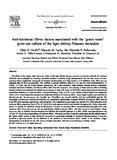Efficiency of Chlorella sp. and Tilapia hornorum in controlling the growth of luminous bacteria in a simulated shrimp culture environment
- Global styles
- MLA
- Vancouver
- Elsevier - Harvard
- APA
- Help

View/
Date
2005Page views
2,545ASFA keyword
AGROVOC keyword
Taxonomic term
Metadata
Show full item record
Share
Abstract
This study clarifies the effect of green water from Chlorella sp., Tilapia hornorum and the combination of the two organisms on the growth of luminous bacteria in a simulated shrimp culture environment. Results showed that the presence of Chlorella sp. (105 cells/ml) alone was not effective in the control of luminous bacteria in shrimp (biomass=80 g/m3) rearing water. The presence of T. hornorum alone (biomass=500 g/m3) was more efficient in controlling the growth of luminous bacteria than the co-existence of tilapia and Chlorella sp. Nevertheless, the presumptive Vibrio count was lowest in control tanks that had the highest shrimp survival rate, which was attributed to the presence of other micro-algae such as Chaetoceros, Thalassiosira, Navicula, Nitszchia, Melosira, and Fragilaria.
Suggested Citation
Tendencia, E., dela Peña, M. R., & Choresca, C. H., Jr. (2005). Efficiency of Chlorella sp. and Tilapia hornorum in controlling the growth of luminous bacteria in a simulated shrimp culture environment. Aquaculture , 249(1-4), 55-62. https://doi.org/10.1016/j.aquaculture.2005.01.027
Type
ArticleISSN
0044-8486Collections
- Journal Articles [1258]
Related items
Showing items related by title, author, creator and subject.
-
Antibacterial activity of tilapia Tilapia hornorum against Vibrio harveyi
Tendencia, Eleonor ; dela Peña, Milagros R.; Fermin, Armando C.; Lio-Po, Gilda; Choresca, Casiano H., Jr.; Inui, Yasuo (Elsevier, 2004)
Disease due to luminous Vibrio has been a major problem of the shrimp industry. Different technologies have been introduced to control the disease. One of the techniques reported to work against luminous bacteria in the ...
; dela Peña, Milagros R.; Fermin, Armando C.; Lio-Po, Gilda; Choresca, Casiano H., Jr.; Inui, Yasuo (Elsevier, 2004)
Disease due to luminous Vibrio has been a major problem of the shrimp industry. Different technologies have been introduced to control the disease. One of the techniques reported to work against luminous bacteria in the ... -
Bacterial diseases of tilapia, their zoonotic potential and risk of antimicrobial resistance
Haenen, Olga ; Thanh Dong, Ha
; Thanh Dong, Ha  ; Hoai, Truong Dinh
; Hoai, Truong Dinh  ; Crumlish, Mags
; Crumlish, Mags  ; Karunasagar, Iddya
; Karunasagar, Iddya  ; Barkham, Timothy
; Barkham, Timothy  ; Chen, Swaine
; Chen, Swaine  ; Zadoks, Ruth
; Zadoks, Ruth  ; Kiermeier, Andreas
; Kiermeier, Andreas  ; Wang, Bing
; Wang, Bing  ; Garrido Gamarro, Esther
; Garrido Gamarro, Esther  ; Takeuchi, Masami
; Takeuchi, Masami  ; Amal, Mohammad Noor Azmai; Fouz, Belén
; Amal, Mohammad Noor Azmai; Fouz, Belén  ; Pakingking, Rolando V., Jr.
; Pakingking, Rolando V., Jr.  ; Zeng, Weiwei
; Zeng, Weiwei  ; Bondad-Reantaso, Melba
; Bondad-Reantaso, Melba  (Wiley, 2023-03-05)
Tilapia culture is an important source of income and nutrition to many rural families. Since 2000, the production of tilapia increased and reached domestic and global markets. Major farmed species is Nile tilapia (Oreochromis ...
(Wiley, 2023-03-05)
Tilapia culture is an important source of income and nutrition to many rural families. Since 2000, the production of tilapia increased and reached domestic and global markets. Major farmed species is Nile tilapia (Oreochromis ... -
Anti-luminous Vibrio factors associated with the ‘green water’ grow-out culture of the tiger shrimp Penaeus monodon
Lio-Po, Gilda D.; Leaño, Eduardo M.; Peñaranda, Ma. Michelle D.; Villa-Franco, Annie U.; Sombito, Christopher D.; Guanzon, Nicholas G., Jr. (Elsevier, 2005)The ability of the “green water” grow-out culture of the tiger shrimp Penaeus monodon to prevent outbreaks of Luminous Vibriosis was investigated by screening associated isolates of bacteria, fungi, phytoplankton and fish ...





